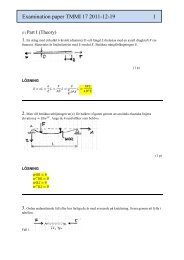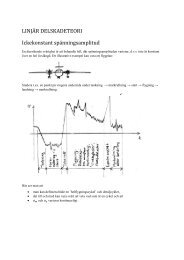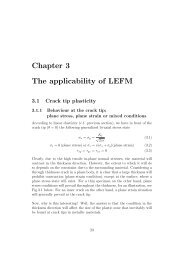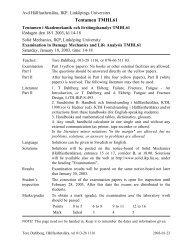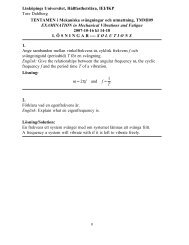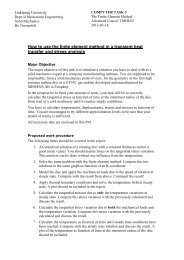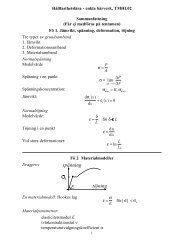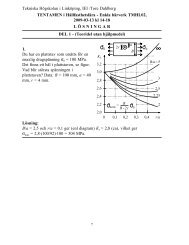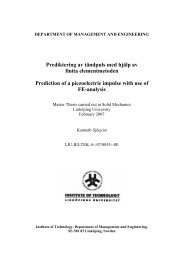PLASTICITY. Flow rule for isotropic hardening
PLASTICITY. Flow rule for isotropic hardening
PLASTICITY. Flow rule for isotropic hardening
You also want an ePaper? Increase the reach of your titles
YUMPU automatically turns print PDFs into web optimized ePapers that Google loves.
<strong>PLASTICITY</strong>. <strong>Flow</strong> <strong>rule</strong> <strong>for</strong> <strong>isotropic</strong> <strong>hardening</strong><br />
For a perfectly plastic material we had the following yield hypothesis:<br />
(1)<br />
which in the von Mises case became<br />
(2)<br />
For an <strong>isotropic</strong>ally <strong>hardening</strong> material, we will, instead, have<br />
(3)<br />
which in the von Mises case can be written<br />
(4)<br />
where is a scalar (called flow stress) that increases monotonically with the plastic de<strong>for</strong>mation.<br />
In the von Mises case it is evident that<br />
is the instantaneous plastic yield limit,<br />
we still keep the main diagonal of the stress space as a symmetry axis of the yield surface and<br />
we keep the circular-cylindrical shape of the yield surface.<br />
What happens as the plastic flow develops is that since increases, the diameter of the von<br />
Original yield surface<br />
f = e – s = 0<br />
Yield surface after plastic flow<br />
f = e – f = 0<br />
Fig. 1 Isotropic <strong>hardening</strong> (von Mises)<br />
Mises cylinder increases. See Fig. 1! This is why this plastic <strong>hardening</strong> is called <strong>isotropic</strong> <strong>hardening</strong>.<br />
The most frequent <strong>isotropic</strong> <strong>hardening</strong> description results from setting<br />
(5)
In case of von Mises,<br />
(6)<br />
(From earlier, we know that the definition of is such that ). Note in<br />
particular that Eq. (5) shows that one accumulates during the whole history of plastic strains (even<br />
during unloading, since is squared in the definition). By this, we can there<strong>for</strong>e say that<br />
.<br />
Determination of d <strong>for</strong> the von Mises case<br />
The definition of<br />
[<strong>for</strong> instance, Eq. (6)] and the general flow <strong>rule</strong><br />
(7)<br />
gives a simple relation between and :<br />
(8)<br />
<strong>Flow</strong> <strong>rule</strong>, <strong>isotropic</strong> <strong>hardening</strong>, von Mises<br />
Combining Eqs. (9), (11) and (13) gives the flow <strong>rule</strong><br />
(9)<br />
where the last equality comes from the fact that during plastic flow, . Eq. (9) is sometimes<br />
called the Prandtl-Reuß equation.<br />
The presence of in Eq. (9) is awkward, since we would prefer to have the flow <strong>rule</strong> (which is a<br />
constitutive equation) on the <strong>for</strong>m<br />
. If we postulate that<br />
(10)<br />
by which<br />
(11)<br />
Eq. (9) gives<br />
(12)<br />
We there<strong>for</strong>e want to find .
Fig.2 Uniaxial tensile test curve<br />
Determination of<br />
. Uniaxial tensile test<br />
In a standard uniaxial tensile test, during plastic flow we have<br />
(13)<br />
and<br />
(14)<br />
I.e.,<br />
(15)<br />
and<br />
(16)<br />
In a uniaxial test, Eq. (11) will there<strong>for</strong>e simplify into<br />
(17)<br />
and the function can be found from the test results.<br />
Suppose, <strong>for</strong> instance, that the uniaxial test curve of Fig. 2 has been recorded. In the plastic region one<br />
then has
(18)<br />
Note, there<strong>for</strong>e, that the derivative directly measured in the uniaxial test curve must be<br />
‘postprocessed’ in order to find ’!<br />
In a simple case, this function may be linear, i.e.,<br />
(19)<br />
i.e.,<br />
(20)<br />
The flow <strong>rule</strong> can then be simplified:<br />
(21)<br />
(the 2 nd equality, again, since during plastic flow, ). Note, again, that a linear stiffness<br />
measured in a tensile test must be recalculated in order to find c (i) (see Eq. (18)!).





